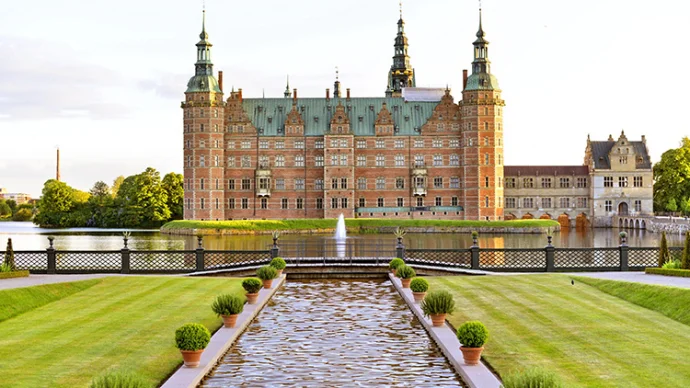
About Rosenborg Slot
Rosenborg Slot (Rosenborg Castle) in North Copenhagen is a 17th century royal palace built by Christian IV.
Rosenborg Slot history
Construction of Rosenborg Slot began in 1606 with the intention that it become a summer home for Danish monarchs, a purpose which it served until Fredensborg Slot was built in the eighteenth century.
The Rosenborg Castle is a magnificent Renaissance palace in a large park in central Copenhagen. The palace is furnished in the style of the absolute monarchs of Denmark from the 17th to 19th centuries while the Danish crown jewels and the royal treasury are in the basement cellars of the castle. Rosenborg Slot is one of the top sights to see in Copenhagen.
Christian IV erected the Rosenborg as a pleasure palace in the early 1600s and it soon became his favourite Copenhagen residence.
The castle began humbly as a small summer palace, but over the course of 28 years it went through four stages of development, and the castle we know today was finished in 1633. Christian IV loved the castle so much that on his deathbed at Frederiksborg he commanded that he be transported by sleigh to Rosenborg in order to end his days there.
With its high towers and red brick walls ornamented with sandstone, Rosenborg stands today as a prime example of Christian IV’s many building works, fully formed despite many changes along the way. It was built in the particular Dutch Renaissance style, which became typical of Danish buildings of the period.
Rosenborg was used as a royal residence until around 1710, when Christian IV’s great-grandchild Frederik IV gave it up in favour of other, more up-to-date summer residences. Instead, he had the palace made into the home of the royal collections.
After 1710, Rosenborg was only used as a royal residence on two occasions, both emergencies: after the fire at Christiansborg in 1794, and during the English attack on Copenhagen in 1801.
The castle opened as a public museum in 1838.
Rosenborg Slot today
Today, Rosenborg Slot is a popular tourist attraction where visitors can admire its opulent Dutch-Renaissance brickwork, a vast collection of paintings and even the Crown Jewels, contained in the incredible underground treasury.
A tour of the castle also offers an insight into the history of the Danish royal family. This picturesque site also features as one of our top visitor sights in Denmark.
Experiencing the Rosenborg Castle is split into two sections: the castle and the treasury. Two separate entrances to the north of the palace are used, so preserve tickets for the second inspection.
Getting to Rosenborg Slot
The Rosenborg Castle, Øster Voldgade 4A, 1350 Copenhagen K, is inside the large Konghaven (King’s Gardens) in the outer edges of central Copenhagen. It is within easy walking distance of the heart of Copenhagen. Entry is through the park or from Øster Voldgade.
Nørreport station (trains, metro, busses) is a short walk from the Rosenborg Castle. Bus stop Georg Brandes (buses 6A, 23, 184, 185) is closest to the main entrance.
Featured In

Christian IV Historic Sites
Follow in the footsteps of Denmark and Norway's famed ruler: these 5 sites and monuments across Scandinavia reveal the history of King Christian IV.

Denmark Historic Sites
Explore the Viking past at Jelling or visit the setting of Shakespeare's Hamlet at Kronborg Castle. Denmark's historic sites are wide-ranging and beguiling.




















